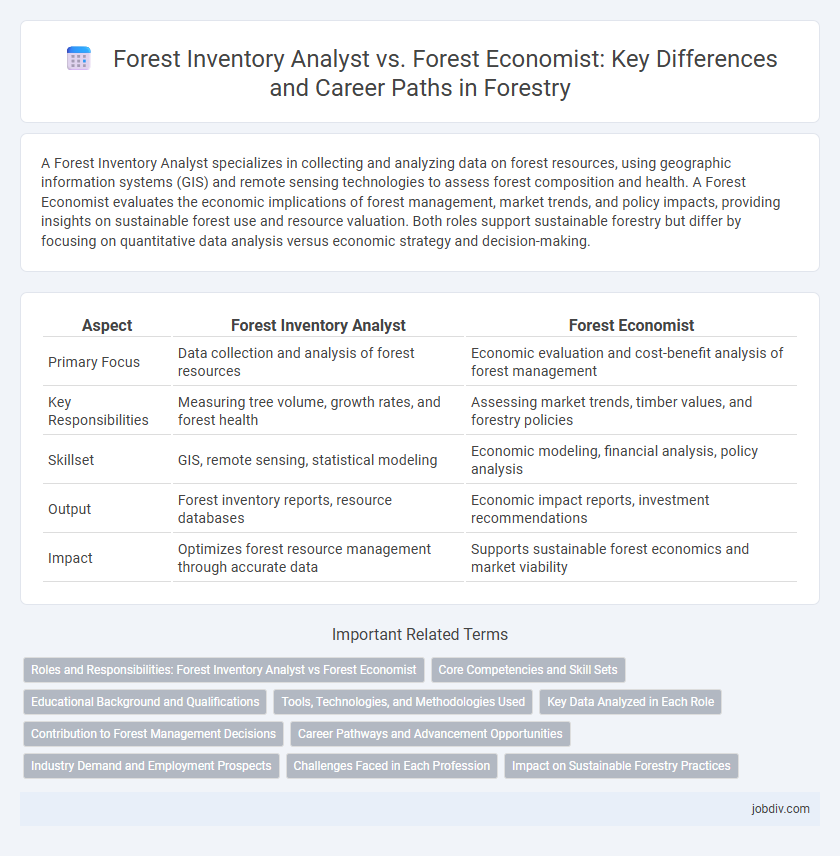A Forest Inventory Analyst specializes in collecting and analyzing data on forest resources, using geographic information systems (GIS) and remote sensing technologies to assess forest composition and health. A Forest Economist evaluates the economic implications of forest management, market trends, and policy impacts, providing insights on sustainable forest use and resource valuation. Both roles support sustainable forestry but differ by focusing on quantitative data analysis versus economic strategy and decision-making.
Table of Comparison
| Aspect | Forest Inventory Analyst | Forest Economist |
|---|---|---|
| Primary Focus | Data collection and analysis of forest resources | Economic evaluation and cost-benefit analysis of forest management |
| Key Responsibilities | Measuring tree volume, growth rates, and forest health | Assessing market trends, timber values, and forestry policies |
| Skillset | GIS, remote sensing, statistical modeling | Economic modeling, financial analysis, policy analysis |
| Output | Forest inventory reports, resource databases | Economic impact reports, investment recommendations |
| Impact | Optimizes forest resource management through accurate data | Supports sustainable forest economics and market viability |
Roles and Responsibilities: Forest Inventory Analyst vs Forest Economist
Forest Inventory Analysts specialize in collecting, analyzing, and managing data on forest composition, growth, and health to inform sustainable management practices. Forest Economists evaluate the economic impacts of forest use, focusing on market trends, resource valuation, and policy implications to optimize economic returns while ensuring conservation. Both roles contribute essential expertise for comprehensive forest management, with Analysts emphasizing data accuracy and Ecologists prioritizing economic viability.
Core Competencies and Skill Sets
Forest Inventory Analysts specialize in data collection, GIS mapping, and statistical analysis to assess forest resources, emphasizing skills in remote sensing and spatial data management. Forest Economists focus on economic modeling, cost-benefit analysis, and market trend evaluation to optimize forest management and policy decisions, requiring strong competencies in economic theory and quantitative methods. Both roles demand proficiency in resource assessment but diverge with Analysts prioritizing technical data interpretation and Economists emphasizing economic impact and sustainable development strategies.
Educational Background and Qualifications
Forest Inventory Analysts typically hold degrees in forestry, environmental science, or natural resource management with strong skills in data collection, GIS, and statistical analysis, often complemented by certifications in forest measurement techniques. Forest Economists usually possess advanced degrees in forest economics, environmental economics, or resource economics, emphasizing economic modeling, policy analysis, and cost-benefit evaluation within forest management. Both professions require proficiency in quantitative methods, but Forest Economists focus more on economic theory and market analysis, while Forest Inventory Analysts specialize in ecological data and inventory assessments.
Tools, Technologies, and Methodologies Used
Forest Inventory Analysts utilize geographic information systems (GIS), remote sensing technologies, and inventory software to collect and analyze spatial forest data, enabling precise volume and health assessments. Forest Economists apply econometric models, cost-benefit analysis tools, and market simulation software to evaluate forest resource valuation, economic impacts, and policy implications. Both professionals employ statistical software like R or Python, but their methodologies diverge with analysts emphasizing biophysical measurements and economists focusing on economic forecasting and optimization models.
Key Data Analyzed in Each Role
Forest Inventory Analysts primarily focus on quantitative data such as tree species composition, stand density, tree diameter, height measurements, and growth rates to assess forest conditions. Forest Economists analyze economic data including timber market prices, cost-benefit analyses of forest management practices, and financial impacts of conservation policies. Both roles rely on geographic information systems (GIS) and remote sensing data but apply them to distinct analytical frameworks centered on ecological metrics versus economic valuation.
Contribution to Forest Management Decisions
Forest Inventory Analysts provide critical quantitative data on tree species, volume, and health, enabling precise assessments of forest resources for sustainable planning. Forest Economists interpret these data to evaluate economic impacts, cost-benefit analyses, and policy implications that guide investment and conservation strategies. Their combined expertise ensures balanced forest management decisions integrating ecological data with economic viability.
Career Pathways and Advancement Opportunities
Forest Inventory Analysts primarily focus on collecting and analyzing data on forest conditions, enabling precise resource management and conservation strategies. Forest Economists apply economic principles to evaluate forest resource use, market trends, and policy impacts, supporting sustainable economic development within forestry sectors. Career advancement for Forest Inventory Analysts often leads to specialized roles in data science and forest management, while Forest Economists typically progress into policy advisory, economic consultancy, or academic research positions.
Industry Demand and Employment Prospects
Forest Inventory Analysts are in high demand for their expertise in collecting and analyzing forest resource data to support sustainable management practices, with employment prospects growing in government agencies, environmental firms, and timber companies. Forest Economists focus on the valuation and economic impact of forest resources, driving industry decisions in policy development and market analysis, leading to strong demand in research institutions, consulting firms, and public sector roles. Both professions offer robust career opportunities due to increasing emphasis on sustainable forestry, climate change mitigation, and resource optimization across global forestry sectors.
Challenges Faced in Each Profession
Forest Inventory Analysts face challenges in collecting accurate, up-to-date data amidst difficult terrain and changing forest conditions, requiring expertise in remote sensing and GIS technologies. Forest Economists encounter complexities in modeling the economic impacts of forest management policies, market fluctuations, and valuation of ecosystem services under uncertainty. Both professions demand advanced analytical skills but differ in the scope of data interpretation and application to sustainable forestry decision-making.
Impact on Sustainable Forestry Practices
Forest Inventory Analysts collect and analyze data on forest composition, growth, and health, providing critical information that supports sustainable forest management plans and ensures precise monitoring of ecosystem changes. Forest Economists evaluate the economic impacts of forestry activities, balancing resource extraction with long-term environmental and social benefits, which guides policy development for sustainable resource use. Their combined expertise drives evidence-based decision-making that promotes the resilience and sustainability of forest ecosystems.
Forest Inventory Analyst vs Forest Economist Infographic

 jobdiv.com
jobdiv.com